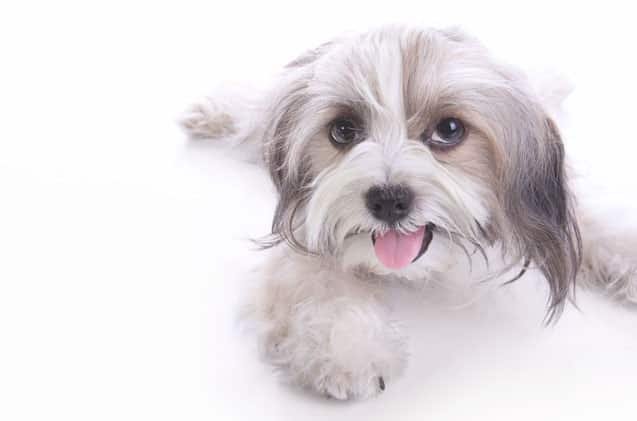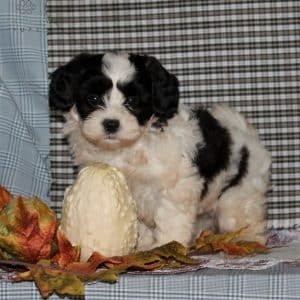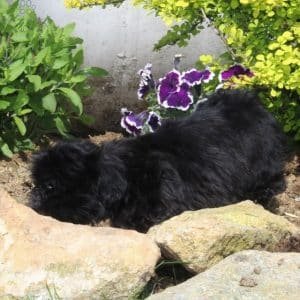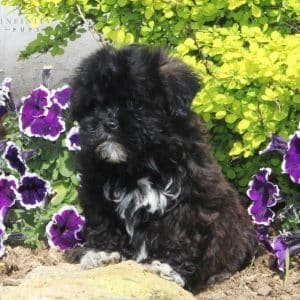Have a question about our Havashu puppies?
"*" indicates required fields
overview of the Havashu Dog Breed
Are you looking for a smart, active companion who will never run out of energy?
Browse our Havashu puppies for sale!
The Havashu loves to be on the go and will play all day if allowed. They can lean towards being hyperactive if they don’t have an outlet for their exuberance. Energetic, responsive, and intelligent, they take well to the stimulation of training. They love to please, but they have a stubborn streak as well, and sometimes have their own ideas about things.
The Havashu is a toy dog, but they are quite sturdy for their size. They do great with kids and other pets, and make good family dogs.
If you are looking for a lively, spirited, fun-loving friend, then pick out your Havashu puppy today!
Browse our other puppies for sale on our “all breeds” page.
Havashu temperament
Energetic – Havashus are fairly high-energy. They love to rip around and play, and can get hyperactive at times. They need a good amount of exercise and stimulation, or they may become bored and destructive. Havashus can also be prone to chasing other animals as prey, wanting excitement. Early socialization will help prevent this.
Responsive – Because they are so lively, Havashus respond well to training and interaction. Lots of healthy stimulation will keep them happy and content.
Alert – Havashus are usually alert to their surroundings. Occasional barkers, they will let you know if there is a stranger at the door.
Adaptable: Havashus are relatively adaptable dogs. They can thrive in both apartments and houses, and their small size makes them suitable for urban living.
Curious: Havashu puppies are often curious about their environment. They like to explore their surroundings and may investigate new scents and objects.
Outgoing – While they will be sure to warn you of visitors, your Havashu will be friendly with your guests. They love meeting new people!
Stubborn – Havashus inherit a stubborn streak from their Shih-tzu parentage. They can be feisty and strong-willed at times. However, below the sassy attitude, they really do want to please their beloved masters.
As with any mixed breed, individual puppies can exhibit a combination of traits from both parent breeds. Early socialization, consistent training, and providing them with love and attention are key to raising a well-adjusted Havashu companion.
Havashu Breed history
The Havashu is a designer breed, so it is fairly recent in its origins. It has probably been around for 30-40 years. However, its parent breeds both have lengthy histories, and by looking at these histories we can better understand the Havashu:
The Shih-tzu dates back 800 years or so to ancient China or Tibet. It was a prized companion dog known as the “little lion” because of its long, silky hair. They made an appearance in England in 1928, and were recognized as an official breed by the AKC in 1969. Still companion dogs today, Shih-tzus are affectionate and love attention.
The ancestors of the Havanese breed originated in Spain, and were brought to Cuba by Spanish settlers. There, they were named for the Cuban capital, Havana. The Havanese is also a companion breed with a thick, silky coat and a gentle nature. The Havanese needs lots of company and doesn’t do well when left alone. They don’t bark much and make wonderful companions.
The Havapoo is a close cousin of the Havashu.
Havashu Average size
Havashus stand around 8-12″ at the shoulder and weigh 7-15 lbs. Although they are a toy breed they are sturdy and not overly fragile. However, it is still good to teach small children not to be too rough with them.
Average Havashu lifespan
Havashus generally live to be 12-16 years old.
Havashu body features
Small and sturdy, the Havashu’s back legs are usually a little longer than its front legs. This makes its hindquarters slightly higher than its shoulders. The Havashu’s coat can vary depending on which parent it takes after. It can be long and silky, or short and curly.
Common colors include brown, gray, cream, golden, black, white, and chocolate. Havashus can sometimes have comical, curling tails, and their ears tend to be floppy and silky.
grooming Your Havashu Puppy
Havashus are not heavy shedders, but their wavy coats require regular brushing to prevent matting and tangling. If your Havashu has a longer coat, it should be clipped by a groomer. The Havashu’s floppy ears pick up grime easily, and should be cleaned regularly. Also, because smaller dogs are more prone to dental issues, your Havashu’s teeth should be brushed regularly as well.
Keeping Your Havashu Puppy Healthy
Havashus are generally healthy dogs. However, they are not immune to everything, and can inherit health problems from either side of their parentage. Here are some issues you should watch for:
Chondrodysplasia – Sometimes known as canine dwarfism, chondrodysplasia is when a dog’s cartilage and bone doesn’t form correctly. It results in abnormally short legs.
Bladder stones – Watch for blood in your dog’s urine or signs that your dog is having trouble urinating.
Ear infections – The Havashu’s floppy ears easily become dirty, and can become infected if not cleaned.
Like all dog breeds, they are susceptible to hip and elbow dysplasia, two of the most common health issues among dogs.
Hip and elbow dysplasia occurs when the leg or hip becomes weakened, and it can result in arthritis or potential lameness if not addressed.
One of the best ways to prevent this is by keeping your dog from running too much on hard surfaces, especially when they are puppies.
Typical Havashu Allergens
Allergens are caused by dander, which is dead skin cells. These skin cells are shed by any animal, including humans.
If you suffer from allergies, good news! Both the Shih-tzu and the Havanese are considered by many to be hypoallergenic. So the Havashu should be hypoallergenic as well.
However, there is no such thing as a truly hypoallergenic dog. If you have someone in your home with allergy concerns, it is good to consult your family physician.
- 1. Are Havashus feisty?Yes, Havashus are lively, feisty little dogs! Their spunky side can be charming if properly handled, but for some, it may seem like an unnecessary training obstacle.
- 2. Do Havashus need a lot of exercise?Havashus are pretty high-energy and will need a moderate amount of exercise per day, such as a daily walk or some playtime in the yard. They don’t necessarily need a huge yard to play in since they are small, but they would love to rip around in a wide open space! Be sure to provide your Havashu with adequate mental stimulation as well as exercise to keep her from becoming bored and destructive. Havashus are excellent candidates for dog sports such as agility since such activities combine physical and mental stimulation.
- 3. How much do Havashus bark?Barking tendencies always vary with individual dogs. But as a breed, Havashus tend to be moderate barkers, not excessive barkers. You may get an exceptionally quiet or exceptionally loud pup, depending on his personality.
- 4. Are Havashus easy to train?Havashus are people pleasers, but they do occasionally have their own ideas about things. This stubborn streak means that training may take some extra time and patience.
- 5. Are Havashus friendly with children?Havashus and children are a great mix, and on the whole, they get along wonderfully. A lively Havashu makes for a fun playmate and is sturdier than you give her credit for, so she’s not easily hurt. However, it’s always a good idea to teach your kids to play gently.
- 6. How much do Havashus shed?Havashus are not heavy shedders, but they do shed some. Their fluffy coats require regular brushing to stay looking nice.
- 7. Do Havashus get along well with other pets?Your other pets don’t have much to fear from your Havashu except the occasional game of chase. Havashus enjoy chasing anything and everything. However, on the whole, Havashus are an easy-going breed and get along well with other pets.
- 8. Are Havashus friendly with strangers?Yes! Havashus will bark when a stranger shows up, just to let you in on what’s happening, but they tend to accept and love everyone at first sight. That means they aren’t effective as guard dogs, although they are effective doorbells.
- 9. Do Havashus require a lot of socialization?Havashus LOVE to socialize with people and thrive best when they are allowed to be in on everything. They don’t make good kennel dogs, but prefer to be with their families 24-7.
- 10. Are Havashus known for any specific quirks?These lively dogs are full of quirks, some lovable and others not-so-lovable. For one thing, they may enjoy chasing anything and everything as prey, wanting to create excitement for themselves. For another, they have a little stubborn streak and a good dose of spunk. They are noted for their surprising sturdiness. You wouldn’t expect that so tiny and fluffy a pup could be so tough! Also, if you look closely, you may notice that their back legs are slightly longer than their front legs, making their hindquarters slightly higher than their shoulders. Overall, Havashus are a delightfully lively and quirky breed!










